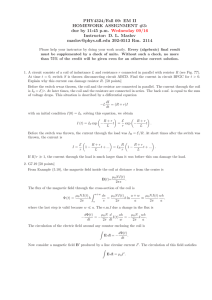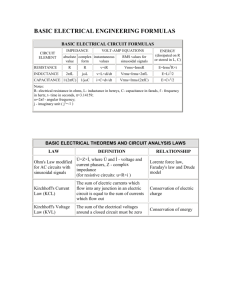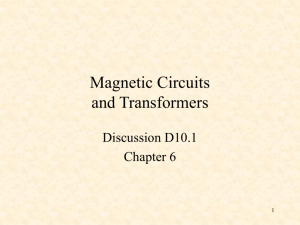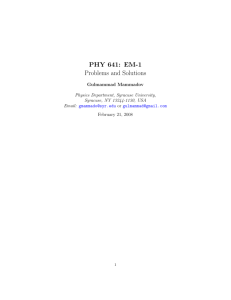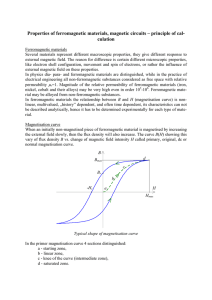ELECTRO-MAGNETIC INTERACTION interaction between energy domains.
advertisement
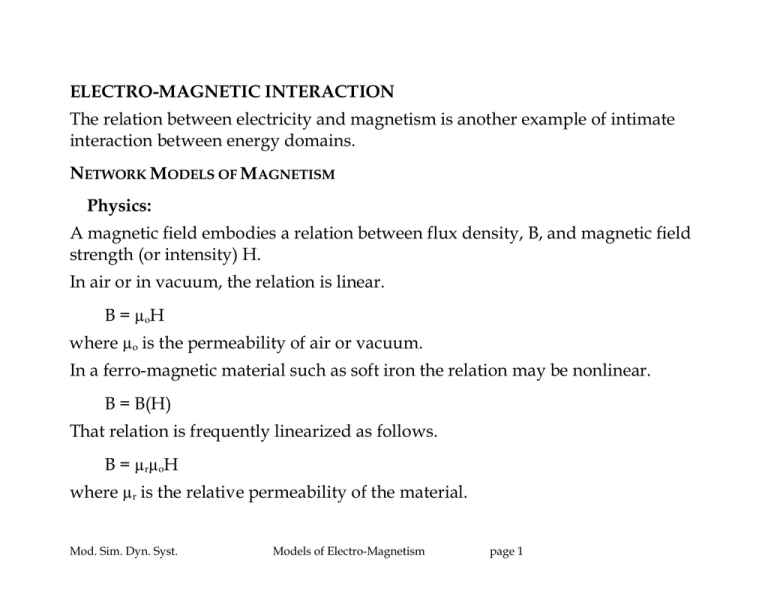
ELECTRO-MAGNETIC INTERACTION The relation between electricity and magnetism is another example of intimate interaction between energy domains. NETWORK MODELS OF MAGNETISM Physics: A magnetic field embodies a relation between flux density, B, and magnetic field strength (or intensity) H. In air or in vacuum, the relation is linear. B = µoH where µo is the permeability of air or vacuum. In a ferro-magnetic material such as soft iron the relation may be nonlinear. B = B(H) That relation is frequently linearized as follows. B = µrµoH where µr is the relative permeability of the material. Mod. Sim. Dyn. Syst. Models of Electro-Magnetism page 1 Network variables: Magnetomotive force, F: F =Hl where l is the length of the magnetic path. Magnetic flux, ϕ: ϕ=BA where A is the cross-sectional area of the magnetic path. In the linear case: F = (l/µrµoA)ϕ = R ϕ where R is the reluctance of the magnetic path. Mod. Sim. Dyn. Syst. Models of Electro-Magnetism page 2 THE FLAW IN THE CONVENTIONAL ANALOGY —REPRESENT A MAGNETIC PATH AS AN ELECTRICAL RESISTOR magnetomotive force ↔ electromotive force (voltage) magnetic flux ↔ electrical current magnetic reluctance ↔ electrical resistance A SERIOUS FLAW: A magnetic field stores energy An electrical resistor dissipates energy (to be precise, a resistor dissipates free energy—more on this later) Mod. Sim. Dyn. Syst. Models of Electro-Magnetism page 3 AN ENERGETICALLY CONSISTENT ANALOGY —REPRESENT A MAGNETIC PATH AS A CAPACITOR 1/R : C F d ϕ/ d t (inverse) capacitance ↔ magnetic reluctance effort ↔ magnetomotive force displacement ↔ magnetic flux flow ↔ magnetic flux rate Mod. Sim. Dyn. Syst. Models of Electro-Magnetism page 4 NETWORK MODELS OF ELECTRO-MAGNETISM A magnetic field may be generated by a coil of wire carrying a current. electrical connections soft iron core Magnetomotive force F =Ni where N is the number of turns of wire in the coil. cutaway section of coil Magnetomotive force is an effort variable electrical current is a flow variable. —one constitutive equation of a gyrator Mod. Sim. Dyn. Syst. Models of Electro-Magnetism page 5 The amount of flux “linked” by the coil is the flux linkage, λ λ = Nϕ Faraday's law: The rate of change of flux linkage determines the voltage across the coil. dλ dϕ = N dt dt e = N ϕ̇ —the other constitutive equation of the gyrator F dϕ/dt GY N e = dλ/dt i = dq/dt ELECTRO-MAGNETIC COUPLING MAY BE REPRESENTED AS A GYRATOR Mod. Sim. Dyn. Syst. Models of Electro-Magnetism page 6 ELECTRICAL INDUCTOR A coil of wire wrapped on a ferro-magnetic core may be modeled by a (magnetic) capacitor and a gyrator. magnetic domain electrical domain e = dλ/dt F : 1/R C GY dϕ/dt i = dq/dt N Bond graph of a simple electromagnetic coil model. It often serves as an electrical circuit component. Equivalent electrical behavior —an inductor. N2/R : I Mod. Sim. Dyn. Syst. e = dλ/dt i = dq/dt Models of Electro-Magnetism page 7 Assuming magnetic linearity, the electrical constitutive equation is N2 λ= R i=Li where L = N2/R is the inductance of the coil. Differentiating results in a more familiar form. e = L di/dt ELECTRICAL INDUCTOR BEHAVIOR IS MAGNETIC CAPACITOR BEHAVIOR TRANSDUCED THROUGH A GYRATOR. Mod. Sim. Dyn. Syst. Models of Electro-Magnetism page 8
